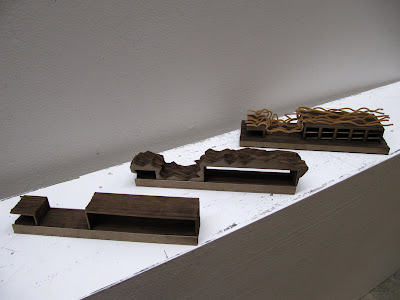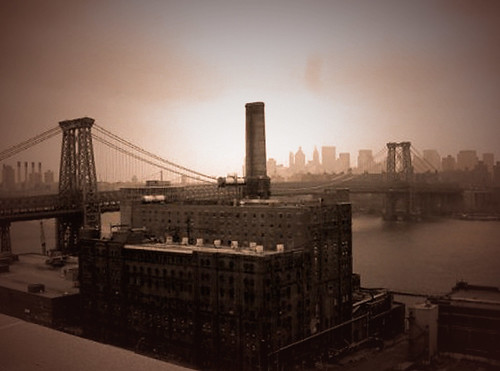
Although this post is written after the mid-term review, I tried to first gather my thought before the mid-term review, then see how it goes after the mid-term.
My approach to the stalled construction site is to find its situation and the "problems" it create then find a solution to that.
The first thing I noticed about the stalled construction site (abbreviation for "SCS") is the disjunction between the SCS and the existing urban pattern. It made me feel the SCS is like the scar on the urban pattern, both from a bird view and a street view. So I tried to look for a "pattern" that can be injected and cure the scar, which is the "green" I notice from the bird view photo. It seems for me, the "green" is like a universal "plug-in" that can be put anywhere within a urban pattern without creating disjunction. What's more, from two different photos but both taken in Williamsburg, the green add a restorative feeling to the neighborhood. Consequently, I started to look into urban farming and made it as my program for now.
After some research of urban farming, I found that the productivity of urban farming is promising, for during WW II, the Victory Garden actually make up 40% of the nation's produce supply. Imagine that all the SCS be developed into the urban farming, its productivity, which is one kind of energy output, cannot be underestimated.
What's more dramatic, there is a quote from the Detroit Chief of Police Ella M. Bully-Cummings:“... the Urban Farming Community gardens help cut down on crime.” This related back to the some of the unsafety issue addressed in one New York Times article, "They went forward with all this stuff, and now we're paying the price," said community activist and Williamsburg resident Phil DePaolo, who said the metal frames and vacant lots strewn across his neighborhood are a magnet for drug addicts and homeless people. 

He kept describing that "An area where you had factories and life, you [now] have emptiness and darkness, and it increases the fear factor in the community,"
Indeed, the uncertainty and unsafty created by the emptiness (in terms of activity) and darkness of the SCS are actually consuming this neighborhood, both physically and psychologically.

So, in addition to the urban farming, I am thinking to bring in illumination activity at night too, such a huge projector to project movie or performance at the wall.
Back to the urban pattern. After the consideration of the program, I started to look at the formal language of the program.
Usually, there is no formal connection between the SCS and the rest of the urban pattern. They are two totally different formal languages.
Thanks to Catie's suggestion, the formal barrier between the SCS and the existing urban pattern could actually be resolve by taking it as a "continuos landscape", a landscape that wrap around both languages, translating them and fusing them. Visually, both the SCS and the existing urban pattern become the support of this "continuos landscape"; Physically, the structure of the "continuos landscape" enables people to move across the SCS and the existing urban pattern.
This "continuos landscape" can exist in many scales. It can exist within 2-3 buildings; or it can grow and take over even the street, becoming a bridge flying upon the street; finally, in vision, it might become a superstructure that to cover the neighborhood, setting up a new skyline of the Williamsburg.
Without doubt, I had two approaches to the SCS, one in terms of program and another one in terms of structure. The next step might be to create a link between them.





















